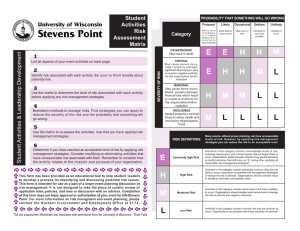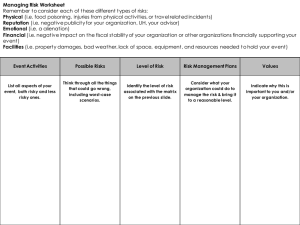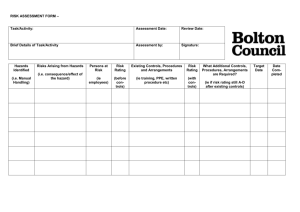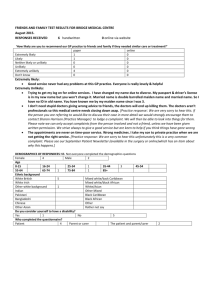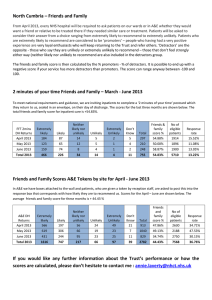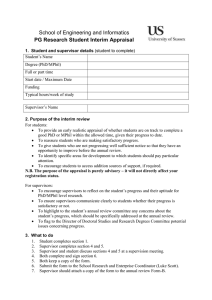RISK ASSESSMENT MATRIX ORGANIZATION:
advertisement
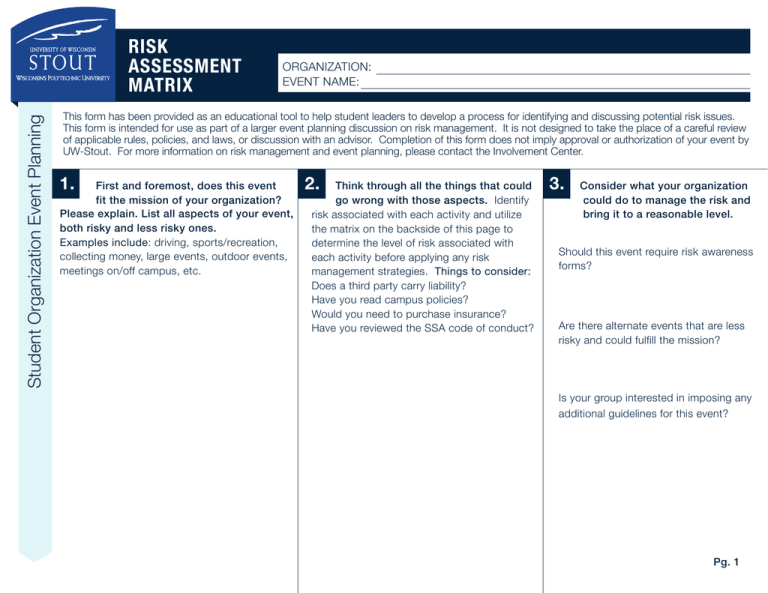
Student Organization Event Planning RISK ASSESSMENT MATRIX ORGANIZATION: EVENT NAME: This form has been provided as an educational tool to help student leaders to develop a process for identifying and discussing potential risk issues. This form is intended for use as part of a larger event planning discussion on risk management. It is not designed to take the place of a careful review of applicable rules, policies, and laws, or discussion with an advisor. Completion of this form does not imply approval or authorization of your event by UW-Stout. For more information on risk management and event planning, please contact the Involvement Center. 1. First and foremost, does this event fit the mission of your organization? Please explain. List all aspects of your event, both risky and less risky ones. Examples include: driving, sports/recreation, collecting money, large events, outdoor events, meetings on/off campus, etc. 2. Think through all the things that could go wrong with those aspects. Identify risk associated with each activity and utilize the matrix on the backside of this page to determine the level of risk associated with each activity before applying any risk management strategies. Things to consider: Does a third party carry liability? Have you read campus policies? Would you need to purchase insurance? Have you reviewed the SSA code of conduct? 3. Consider what your organization could do to manage the risk and bring it to a reasonable level. Should this event require risk awareness forms? Are there alternate events that are less risky and could fulfill the mission? Is your group interested in imposing any additional guidelines for this event? Pg. 1 Determine the level of risk associated with your event by reviewing the matrix below. Once finished, determine if you have reached an acceptable level of risk by applying risk management strategies. If not, consider modifying or eliminating activities that have unreasonable risk associated with them. PROBABILITY THAT SOMETHING WILL GO WRONG FREQUENT CATEGORY CATASTROPHIC May result in death. SEVERITY OF RISK CRITICAL May cause severe injury, major property damage, significant financial loss, and/or result in negative publicity for the organization and/or institution. MARGINAL May cause minor injury, illness, property damage, financial loss and/or result in negative publicity for the organization and/or institution. NEGLIGIBLE Hazard presents a minimal threat to safety, health and well-being of participants; trivial. LIKELY Likely to occur Quite likely to immediately or occur in time in a short period of time, expected to occur frequently E E E H OCCASIONAL May occur in time H H SELDOM Not likely to occur but possible H M UNLIKELY Unlikely to occur M L M M L L M L L L L After reviewing risk assesment this event is determined to be: Many events, without proper planning, can have unreasonable levels of risk. However, by applying risk management strategies you can reduce the risk to an acceptable level. EXTREMELY HIGH RISK Activities in this category contain unacceptable levels of risk, including catastrophic and critical injuries that are highly likely to occur. Organizations should consider whether they should eliminate or modify activities that still have an “E” rating after applying all reasonable risk management strategies. H HIGH RISK Activities in this category contain potentially serious risks that are likely to occur. Application of proactive risk management strategies to reduce the risk is advised. Organizations should consider ways to modify or eliminate unacceptable risks. M MODERATE RISK Activities in this category contain some level of risk that is unlikely to occur. Organizations should consider what can be done to manage the risk to prevent any negative outcomes. L LOW RISK Activities in this category contain minimal risk and are unlikely to occur. Organizations can proceed with these activities as planned. E H STUDENT ORG LEADER & ADVISOR: RISK DEFINITIONS NOT RECOMMENDED (State Rationale): CONFIRM: DEFER TO INVOLVEMENT CENTER FOR ADVICE: Sign (ADVISOR) Date Sign (STUDENT ORG LEADER) Date Pg. 2
